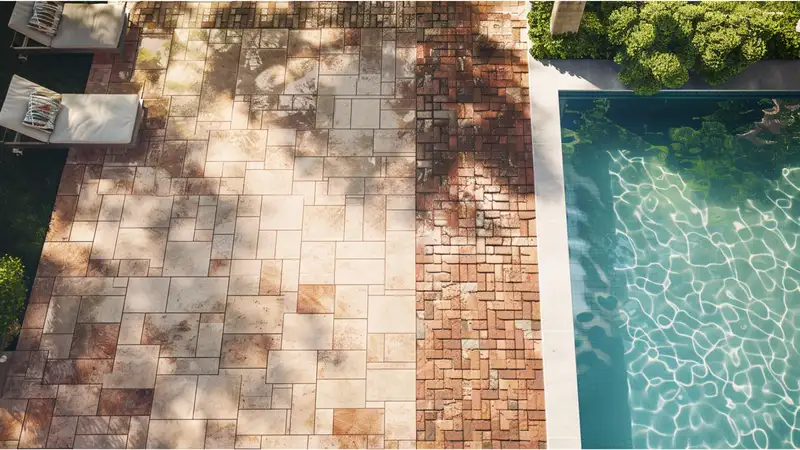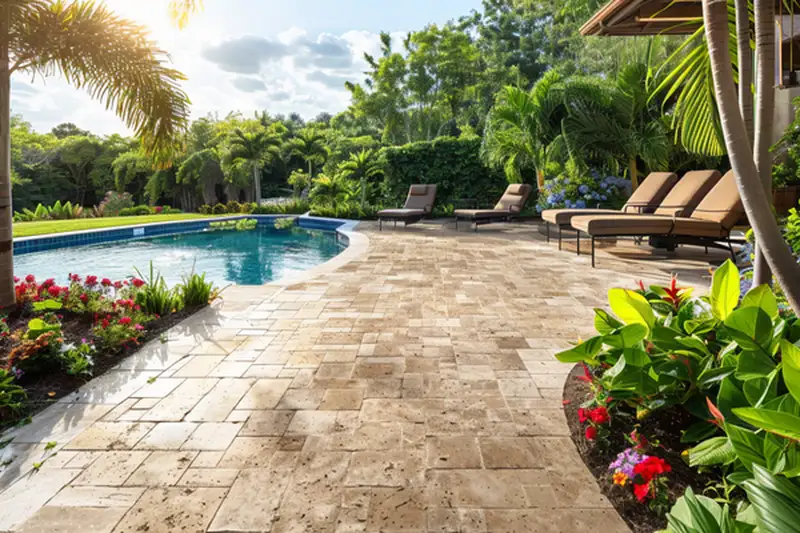Travertine Pavers vs Brick Pavers: Which Is the Better Choice?
Choosing the right paving material sets the foundation for your entire outdoor design. Whether you are planning a pool deck, a patio, a driveway, or a garden walkway, the choice between travertine pavers and brick pavers will significantly influence comfort, aesthetics, durability, and long-term value. In this in-depth guide, we will compare the two side by side to help you make the right investment for your home.

What Are Travertine and Brick Pavers?
Travertine pavers are cut from natural limestone, known for their porous texture, timeless beauty, and ability to stay cool underfoot. With tumbled or chiseled finishes, they deliver a high-end, resort-style look that feels luxurious yet functional.
Brick pavers are kiln-fired clay units, valued for their strength, color consistency, and rustic appeal. They have been used for centuries in driveways, courtyards, and walkways, offering a sense of tradition and durability.
Travertine vs Brick: Side-by-Side Comparison
| Criteria | Travertine Pavers | Brick Pavers |
|---|---|---|
| Aesthetics | Unique natural veining and color variation; luxurious and organic look. | Classic, uniform color; rustic charm and historic appeal. |
| Heat Resistance | Remains cool under direct sunlight; perfect for pool decks. | Can retain heat; may feel hot on bare feet in summer. |
| Slip Resistance | Tumbled finish offers excellent grip, even when wet. | Moderate slip resistance; depends on texture and sand joints. |
| Durability | Strong and resilient; sealing enhances resistance to stains. | Extremely durable; handles heavy loads well. |
| Freeze–Thaw Performance | Performs well with proper drainage and breathable sealer. | Stable in cold climates; joints may need refilling. |
| Maintenance | Requires periodic sealing; easy to clean with mild detergent. | Low maintenance; occasional sand replacement needed. |
| Cost & Value | Higher initial cost; strong resale value and premium appearance. | Lower upfront cost; long-lasting but less premium aesthetic. |
Best Uses and Design Scenarios

Pool Decks & Spas
Travertine is unmatched here. Its cool-touch surface and tumbled finish make it the safest, most comfortable choice around water.
Patios & Courtyards
Travertine brings elegance and luxury, while brick creates a cozy, rustic courtyard feel. Both can be used depending on architectural style.
Walkways & Garden Paths
Brick suits traditional homes and gardens with its uniform appearance, while travertine delivers a natural, upscale feel for contemporary landscapes.
Driveways
Both materials can work if installed correctly. Brick patterns like herringbone increase interlock strength, while travertine adds a premium curb appeal.
Care, Sealing, and Maintenance
Travertine: Use a penetrating, breathable sealer to protect against pool chemicals, oils, and stains. Resealing every 2–3 years is ideal in high-traffic areas.
Brick: Monitor efflorescence (white mineral deposits) and refresh joint sand when necessary. Pressure washing keeps brick looking fresh.
Cost & Value Over Time
Travertine pavers may cost more upfront, but they add a luxury appeal and increase property resale value. Brick pavers are more budget-friendly and extremely durable, though they may not deliver the same high-end look. Over time, the decision comes down to balancing budget vs. aesthetics vs. resale value.
FAQs
Are travertine pavers slippery when wet?
No. Tumbled travertine provides excellent traction even when wet, which is why it’s so popular for pool decks.
Do brick pavers last longer than travertine?
Both can last decades with proper installation and maintenance. Travertine excels in luxury aesthetics, while brick is valued for rugged durability.
Which is better for driveways?
Brick offers strong interlock patterns for heavy loads, while travertine enhances curb appeal. Choose based on your design and load requirements.
Do travertine pavers need sealing?
Yes, sealing is recommended to prevent stains and simplify cleaning. Use a penetrating, non-glossy sealer for best results.

